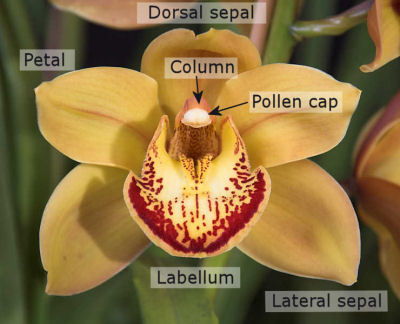Plants use their flowers to attract attention of their pollinators, which include the likes of birds, bees, bats etc. But mind it, we figure nowhere in their scheme of things and are rather a nuisance! We waste a lot of time and energy of the plants when we pluck off their flowers. Flowers play a very crucial part in the life cycle of angiospermic plants (angiosperms are the flower producing plants). Orchids also belong to this group.
Through evolution orchid flowers (like all other plants) have developed varying shapes, sizes, colours, fragrances etc.; this to facilitate the process of pollination. Orchid flowers are zygomorphic, which means that they have a bilateral symmetry. This, in turn, means that when you cut up an orchid flower vertically in the middle, both portions are identical. Orchids being monocots have floral parts in the group of 3’s. They have three sepals, three petals, three fused anthers (filaments) and ovaries (carpels).
The parts common to most orchid flowers are: the pedicel or stalk which joins the flower with the stem. The colourful part of the flower is the perianth, which constitutes the non-reproductive part of the flower. It is attached to the pedicel. Perianth has two whorls of sepals and petals, which maybe free or fused together to form a tube. The two main functions of the perianth are to protect the reproductive parts, especially at bud stage and to facilitate pollination by attracting the pollinating agents (birds and bees!). Unlike most plants, sometimes the sepals of orchid flowers more colourful than the petals and possess colours other than green.
Depending upon the type of pollinators visiting the flower, the orchid develops particular characteristics. Say for example, bright colour is usually seen in bird pollinated flowers, while white coloured and scented flowers are visited by insects (moths and bees).
Sometimes nectaries are also present either at the base of sepals or petals or the ovaries, to provide further incentives to the insect pollinators.
Orchids have dioecious flowers, i.e. both anthers and ovaries are present inside the perianth. The reproductive parts are fused together in the orchid flower, forming a single structure called the column. The column is also referred to as gynostemium, gyandrium etc.
×
You need to log in or sign up before executing this action.
 Photography credit: Dennis Chuah
Photography credit: Dennis Chuah